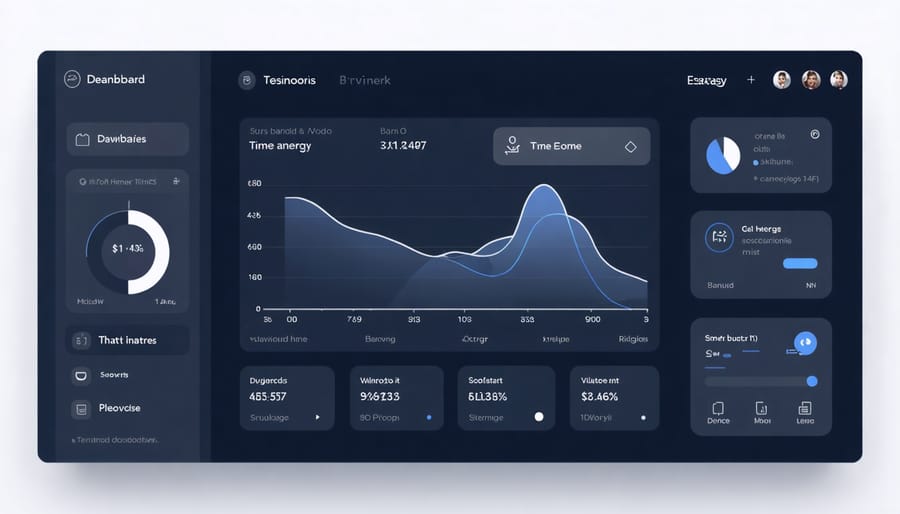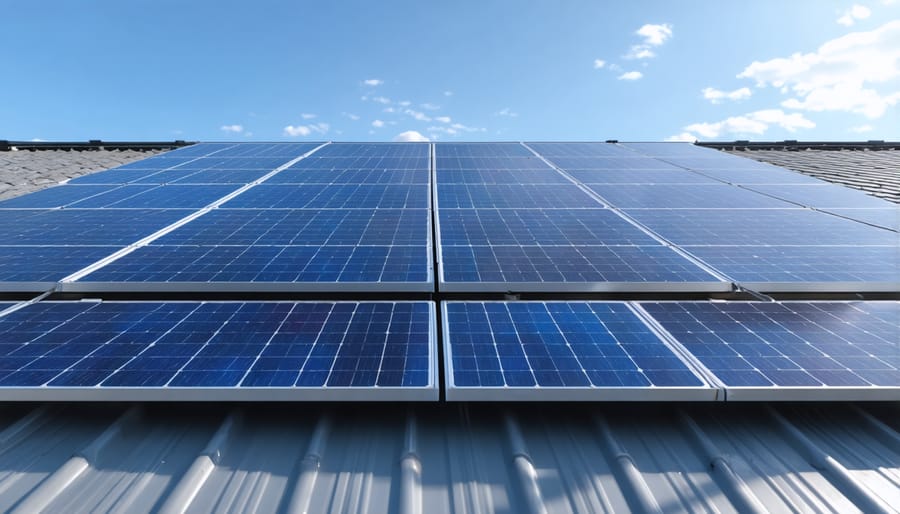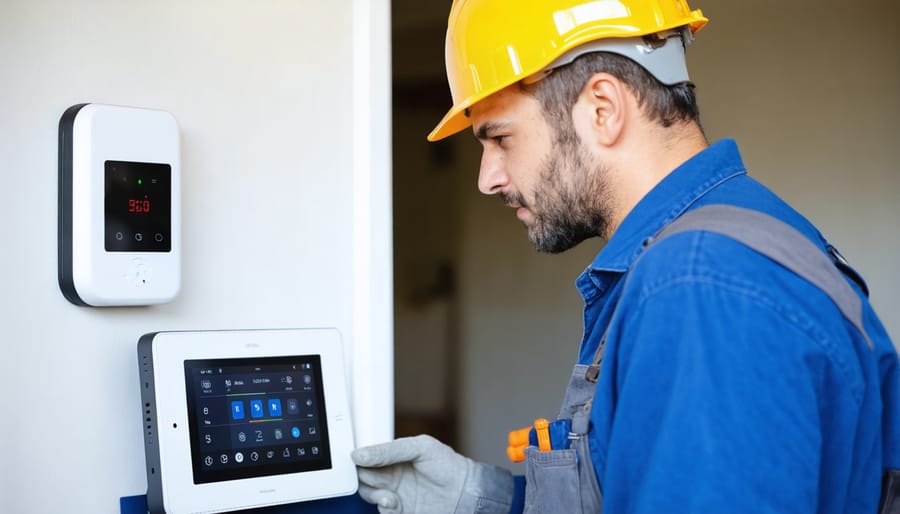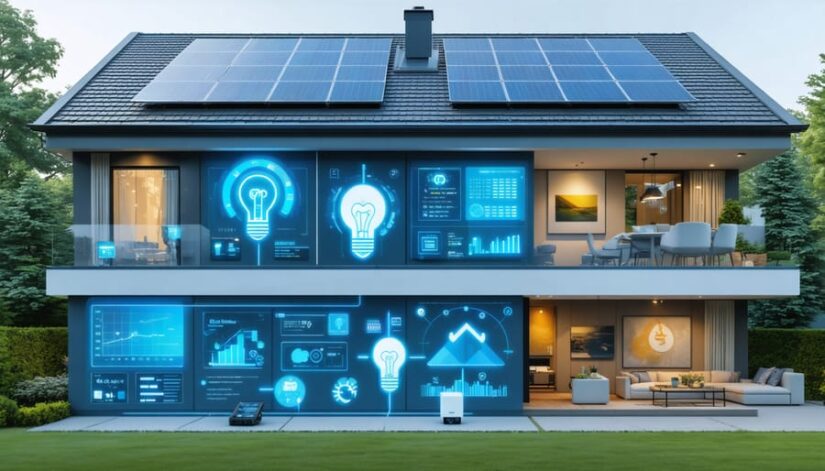Smart Home Energy Systems That Actually Save You Money
Transform your home into an intelligent living space with today’s advanced smart home systems – a network of connected devices that automate, monitor, and optimize your daily life. These integrated technologies combine everything from smart thermostats and security cameras to lighting controls and voice-activated assistants, all manageable through a single smartphone app or central hub.
Modern smart home systems represent a significant leap forward in residential technology, offering Illinois homeowners unprecedented control over their energy consumption, security, and comfort. By automatically adjusting temperature settings, managing lighting schedules, and monitoring energy usage patterns, these systems can reduce utility bills while increasing property value and enhancing everyday convenience.
What sets current smart home technology apart is its seamless integration with renewable energy solutions, particularly solar power systems. This marriage of clean energy and intelligent automation creates a highly efficient, sustainable living environment that responds to your needs while minimizing environmental impact.
What Makes a Home Energy System ‘Smart’?
Key Components of Smart Home Energy Systems
A smart home energy system comprises several interconnected components working together to optimize your home’s energy usage. The central hub or controller acts as the system’s brain, coordinating all connected devices and processing data in real-time. Smart meters track your energy consumption patterns, providing detailed insights into when and how you use power throughout your home.
Connected thermostats automatically adjust heating and cooling based on your preferences and daily routines, while smart outlets and switches enable remote control of individual appliances and fixtures. Motion sensors and occupancy detectors help manage lighting and climate control efficiently, activating only when spaces are in use.
Energy monitoring devices track the performance of major appliances, helping identify energy-hungry equipment that might need maintenance or replacement. For homes with solar installations, power optimizers and smart inverters ensure maximum energy production and seamless integration with the grid.
The software interface, typically accessible through a smartphone app or web portal, brings everything together, offering intuitive controls, detailed energy reports, and personalized recommendations for improving efficiency.
Smart Home Energy Monitoring
Smart home energy monitoring systems serve as your personal energy detective, tracking electricity usage throughout your home in real-time. These intelligent systems connect to your home’s electrical panel and individual smart devices, providing detailed insights into how and where you’re using power. Through user-friendly apps, you can see which appliances consume the most energy, identify peak usage times, and receive alerts about unusual consumption patterns.
The system analyzes this data to help you make informed decisions about your energy use. For example, it might suggest running your dishwasher during off-peak hours or alert you when your HVAC system is working harder than usual. Many systems also integrate seamlessly with solar panels, helping you optimize your renewable energy usage by scheduling high-consumption activities during peak solar production times.
This level of monitoring typically leads to more efficient energy use and lower utility bills, with many homeowners reporting savings of 10-30% on their monthly energy costs.

Integration with Solar Power Systems

Solar Panel Integration Features
Modern smart home systems seamlessly integrate with solar panel installations to maximize energy efficiency and cost savings. These systems monitor real-time solar production, track energy consumption patterns, and automatically adjust power usage to optimize solar energy utilization. Through intuitive smartphone apps, homeowners can view detailed analytics showing their solar generation, grid consumption, and battery storage levels.
Advanced features include intelligent load balancing, which prioritizes running high-energy appliances during peak solar production hours, and automated battery management for storing excess solar power. Some systems even incorporate weather forecasting to predict solar generation and adjust energy usage accordingly. For homes with portable solar solutions, smart systems can track mobile panel performance and integrate this additional power into the home’s energy ecosystem.
The integration also enables automated energy selling back to the grid during optimal price periods, maximizing return on investment for Illinois homeowners. Smart notifications alert users about system performance, maintenance needs, and opportunities to reduce grid reliance, making solar energy management effortless and efficient.
Battery Storage Management
Battery storage management is a crucial component of modern smart home systems, working seamlessly with solar energy storage systems to optimize power usage and reduce utility costs. This intelligent system monitors your home’s energy consumption patterns and automatically manages when to store and use battery power for maximum efficiency.
During peak rate periods, the system can switch to stored battery power, helping Illinois homeowners avoid higher electricity costs. When energy demand is low or during abundant solar production, excess power is directed to battery storage for later use. This smart management also provides backup power during outages, ensuring critical systems remain operational.
The system’s advanced algorithms learn from your daily routines and weather patterns to predict energy needs. It can automatically adjust charging cycles based on forecasted solar production and anticipated household demands. This predictive capability, combined with real-time monitoring through smartphone apps, gives homeowners complete control over their energy usage while maximizing the benefits of their battery investment.
Real Benefits for Illinois Homeowners
Energy Cost Savings
Smart home systems can significantly reduce your energy costs through intelligent automation and monitoring. A typical Illinois household can save 10-30% on their monthly energy bills by implementing smart controls. For example, a smart thermostat learns your schedule and automatically adjusts temperatures, potentially saving $150-$200 annually on heating and cooling costs.
Smart lighting systems with motion sensors and automated schedules can cut lighting electricity usage by up to 50%. When integrated with natural light sensors, these systems optimize light levels throughout the day, reducing unnecessary energy consumption. Smart plugs and outlets that automatically power down devices during non-peak hours can eliminate phantom energy drain, saving an additional $100-$200 per year.
For homes with solar panels, smart energy management systems maximize savings by running energy-intensive appliances during peak solar production hours. The system can automatically schedule your dishwasher, washing machine, and other high-consumption devices to operate when solar power is most abundant, reducing reliance on grid electricity and lowering utility bills even further.
Real-time energy monitoring through smartphone apps helps identify energy waste and unusual consumption patterns, enabling immediate corrective action and promoting more energy-conscious behavior.
Grid Independence and Reliability
Smart home systems play a crucial role in maintaining power reliability, especially during peak usage periods and extreme weather conditions. By intelligently managing your home’s energy consumption, these systems can reduce strain on the grid while ensuring your home stays powered when you need it most.
During summer heat waves or winter storms in Illinois, smart home systems automatically adjust your energy usage based on grid conditions. They can temporarily reduce power consumption of non-essential appliances during peak demand hours, helping prevent brownouts and maintaining stable power supply for critical systems.
When integrated with battery storage and solar panels, smart homes can operate independently during grid outages. The system automatically switches to stored power, prioritizing essential appliances like refrigeration, heating, or medical equipment. This self-sufficiency is particularly valuable during severe weather events that can affect Illinois’s power infrastructure.
Additionally, these systems can participate in demand response programs, earning you credits or incentives from utility companies for reducing energy use during high-demand periods. This not only saves money but contributes to overall grid stability in your community.
Getting Started with Smart Home Energy
System Assessment and Planning
Before diving into smart home technology, it’s crucial to conduct a thorough assessment of your home’s current setup and future needs. Start by creating an inventory of existing devices and systems, including thermostats, lighting, security cameras, and appliances. Consider your daily routines and identify areas where automation could improve efficiency or convenience.
Next, evaluate your home’s infrastructure, particularly your internet connectivity and electrical system. A reliable internet connection is essential for smart home operations, while your electrical system may need updates to accommodate new devices. If you’re considering integrating renewable energy solutions, factor in compatibility with solar panels and energy storage systems.
Develop a priority list based on your immediate needs and long-term goals. Common starting points include smart thermostats for energy management, security systems for peace of mind, or lighting controls for convenience. Consider your budget and plan implementation phases if necessary.
Finally, research compatible platforms and ecosystems. Many homeowners prefer systems that work with existing voice assistants like Alexa or Google Home. Look for devices that use standard protocols like Zigbee or Z-Wave to ensure future compatibility and expansion options. Remember that local climate conditions in Illinois may influence which solutions work best for your home, particularly regarding energy management and weather-related features.

Professional Installation and Setup
While many smart home components offer DIY installation options, professional installation ensures optimal system performance and seamless integration. A certified installer brings expertise in proper device placement, network configuration, and system programming that can make the difference between a functional system and one that truly enhances your lifestyle.
Professional installers begin with a comprehensive home assessment, evaluating your existing electrical infrastructure, internet connectivity, and specific automation needs. They create a detailed installation plan that considers factors like wireless signal strength, device compatibility, and potential interference sources.
The installation process typically involves setting up a central hub or controller, installing smart devices throughout your home, and configuring the network to ensure reliable communication between all components. Professionals also implement necessary security measures, including encrypted connections and secure password protocols, to protect your system from unauthorized access.
Beyond physical installation, professionals handle crucial software setup tasks such as creating automated routines, establishing device schedules, and programming custom scenarios. They also provide valuable training on system operation and maintenance, ensuring you can confidently manage your smart home features.
Most importantly, professional installers offer ongoing support and troubleshooting services, helping you address any issues that arise and adapt your system as your needs evolve. This expertise proves particularly valuable when integrating smart home technology with solar power systems or other advanced energy management solutions.
Smart home systems represent a significant step forward in modern living, offering homeowners unprecedented control, convenience, and energy efficiency. By integrating these technologies into your Illinois home, you can enjoy automated comfort, enhanced security, and substantial energy savings throughout the year. The seamless connection between smart home features and solar energy systems creates a powerful combination that maximizes your investment while reducing your environmental impact. Don’t wait to transform your home into an intelligent, energy-efficient space. Start small with basic automation features and gradually expand your system as you become more comfortable with the technology. The future of home management is here, and it’s more accessible and beneficial than ever before.


